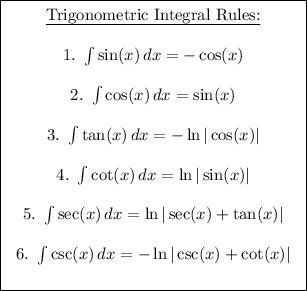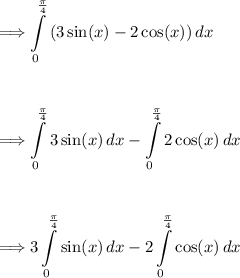Answer:

Explanation:
We are given the following definite integral:

We are asked to evaluate it and leave the answer in exact form.
Basic Integration Rules:
![\boxed{ \left \begin{array}{ccc} \text{\underline{Basic Integration Rules:}} \\\\ 1. \ \int c \, dx = cx \\\\ 2. \ \int cf(x) \, dx = c \int f(x) \, dx \\\\ 3. \ \int [f(x) \pm g(x)] \, dx = \int f(x) \, dx \pm \int g(x) \, dx \\\\ 4. \ \int x^n \, dx = (x^(n+1))/(n+1) \ \text{(Power rule, for } n \\eq -1) \\\\ \text{Where:} \\ \bullet \ c \ \text{is a constant} \\ \end{array} \right.}](https://img.qammunity.org/2024/formulas/mathematics/college/paz9io2nxzypmx4bdvv2qofde03tnbyb24.png)
Basic Trigonometric Integration Rules:


Now solving, lets apply some of the basic integration rules. Apply (3) to split up the integral and (4) to pull out the constants:

Now we have basic sine and cosine trig rules, apply them accordingly:
![\Longrightarrow 3\Big[-\cos(x)\Big]^{(\pi)/(4)}_0 - 2\Big[\sin(x)\Big]^{(\pi)/(4)}_0](https://img.qammunity.org/2024/formulas/mathematics/college/q9z3bgj0u7xpv4xgjs1mt937xjdkm0wzmr.png)
Let's rewrite:
![\Longrightarrow \Big[-3\cos(x)\Big]^{(\pi)/(4)}_0 - \Big[2\sin(x)\Big]^{(\pi)/(4)}_0\\\\\\\\\Longrightarrow \Big[-3\cos(x)-2\sin(x)\Big]^{(\pi)/(4)}_0](https://img.qammunity.org/2024/formulas/mathematics/college/3qr169rga6wqacwxm6jvq80aj8jowwisq0.png)
Now evaluate at the given bounds:
![\Longrightarrow \Big[-3\cos\left((\pi)/(4)\right)-2\sin\left((\pi)/(4)\right)\Big]-\Big[-3\cos(0)-2\sin(0)\Big]](https://img.qammunity.org/2024/formulas/mathematics/college/uqevasq116ia4s0u9n9px64ythz7cilqh1.png)
Using the unit circle (attached as image) we can determine the values of the trig functions:
![\Longrightarrow \Big[-3\left((\sqrt2)/(2)\right)-2\left((\sqrt2)/(2)\right)\Big]-\Big[-3(1)-2(0)\Big]\\\\\\\\\Longrightarrow \Big[(-3\sqrt2)/(2)\right)-\sqrt2\right)\Big]-\Big[-3\Big]\\\\\\\\\Longrightarrow (-3\sqrt2)/(2)\right)-\sqrt2+3\\\\\\\\\Longrightarrow (-3\sqrt2)/(2)\right)-(\sqrt2)/(1)+3\\\\\\\\\Longrightarrow (-3\sqrt2)/(2)\right)-(2\sqrt2)/(2)+3\\\\\\\\](https://img.qammunity.org/2024/formulas/mathematics/college/sh4chgwd3veuph4m21s80g63g6c734p1au.png)

Thus, the problem is solved.